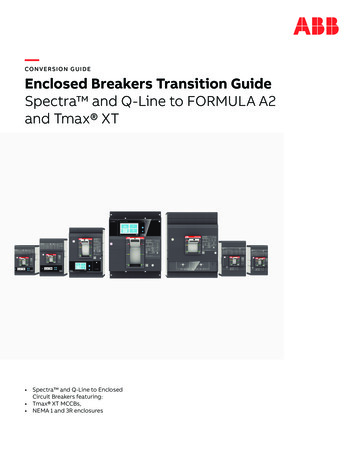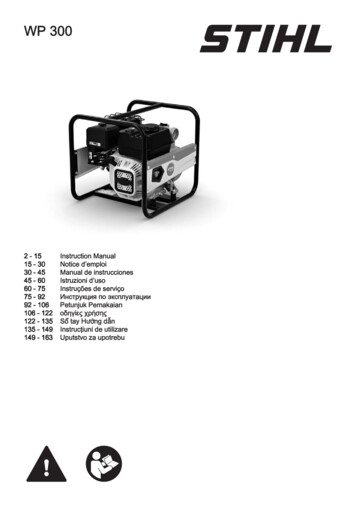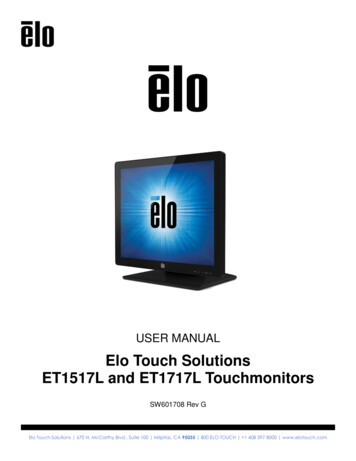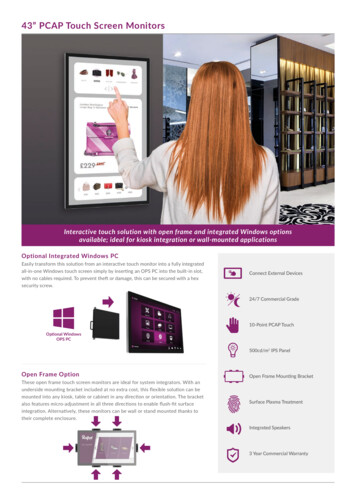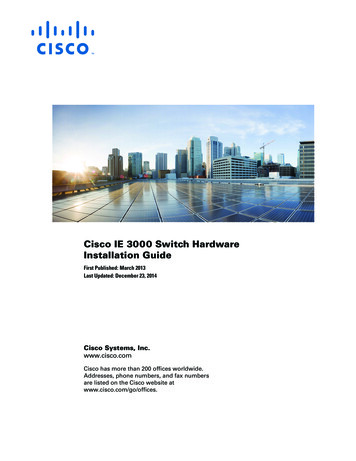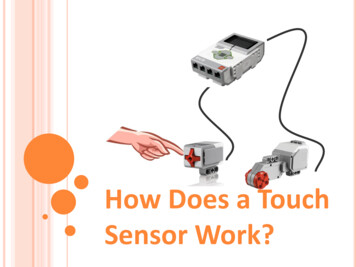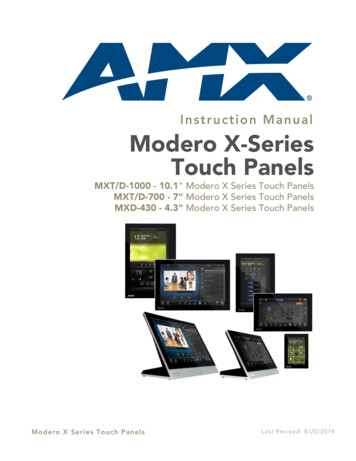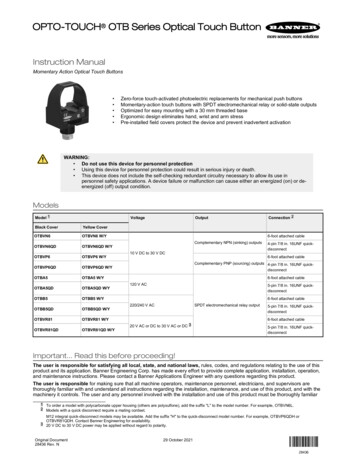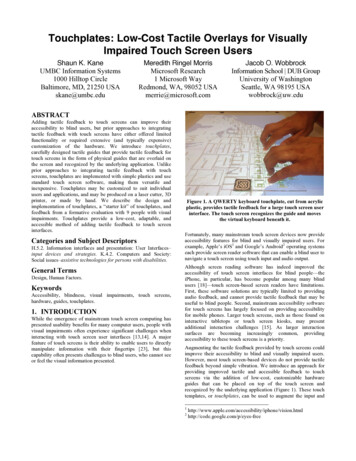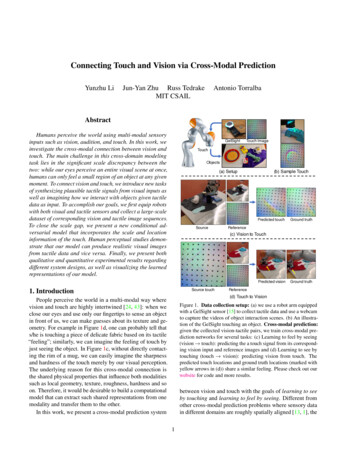
Transcription
Connecting Touch and Vision via Cross-Modal PredictionYunzhu LiJun-Yan Zhu Russ TedrakeMIT CSAILAntonio TorralbaAbstractHumans perceive the world using multi-modal sensoryinputs such as vision, audition, and touch. In this work, weinvestigate the cross-modal connection between vision andtouch. The main challenge in this cross-domain modelingtask lies in the significant scale discrepancy between thetwo: while our eyes perceive an entire visual scene at once,humans can only feel a small region of an object at any givenmoment. To connect vision and touch, we introduce new tasksof synthesizing plausible tactile signals from visual inputs aswell as imagining how we interact with objects given tactiledata as input. To accomplish our goals, we first equip robotswith both visual and tactile sensors and collect a large-scaledataset of corresponding vision and tactile image sequences.To close the scale gap, we present a new conditional adversarial model that incorporates the scale and locationinformation of the touch. Human perceptual studies demonstrate that our model can produce realistic visual imagesfrom tactile data and vice versa. Finally, we present bothqualitative and quantitative experimental results regardingdifferent system designs, as well as visualizing the learnedrepresentations of our model.GelSightTouch ImageTouchObjects(a) Setup(b) Sample TouchPredicted touchSourceGround truthReference(c) Vision to TouchPredicted visionSource touch1. IntroductionGround truthReference(d) Touch to VisionPeople perceive the world in a multi-modal way wherevision and touch are highly intertwined [24, 43]: when weclose our eyes and use only our fingertips to sense an objectin front of us, we can make guesses about its texture and geometry. For example in Figure 1d, one can probably tell thats/he is touching a piece of delicate fabric based on its tactile“feeling”; similarly, we can imagine the feeling of touch byjust seeing the object. In Figure 1c, without directly contacting the rim of a mug, we can easily imagine the sharpnessand hardness of the touch merely by our visual perception.The underlying reason for this cross-modal connection isthe shared physical properties that influence both modalitiessuch as local geometry, texture, roughness, hardness and soon. Therefore, it would be desirable to build a computationalmodel that can extract such shared representations from onemodality and transfer them to the other.In this work, we present a cross-modal prediction systemFigure 1. Data collection setup: (a) we use a robot arm equippedwith a GelSight sensor [15] to collect tactile data and use a webcamto capture the videos of object interaction scenes. (b) An illustration of the GelSight touching an object. Cross-modal prediction:given the collected vision-tactile pairs, we train cross-modal prediction networks for several tasks: (c) Learning to feel by seeing(vision touch): predicting the a touch signal from its corresponding vision input and reference images and (d) Learning to see bytouching (touch vision): predicting vision from touch. Thepredicted touch locations and ground truth locations (marked withyellow arrows in (d)) share a similar feeling. Please check out ourwebsite for code and more results.between vision and touch with the goals of learning to seeby touching and learning to feel by seeing. Different fromother cross-modal prediction problems where sensory datain different domains are roughly spatially aligned [13, 1], the1
scale gap between vision and touch signals is huge. Whileour visual perception system processes the entire scene asa whole, our fingers can only sense a tiny fraction of theobject at any given moment. To investigate the connectionsbetween vision and touch, we introduce two cross-modalprediction tasks: (1) synthesizing plausible temporal tactilesignals from vision inputs, and (2) predicting which objectand which object part is being touched directly from tactileinputs. Figure 1c and d show a few representative results.To accomplish these tasks, we build a robotic system toautomate the process of collecting large-scale visual-touchpairs. As shown in Figure 1a, a robot arm is equipped witha tactile sensor called GelSight [15]. We also set up a standalone web camera to record visual information of bothobjects and arms. In total, we recorded 12, 000 touches on195 objects from a wide range of categories. Each touchaction contains a video sequence of 250 frames, resulting in3 million visual and tactile paired images. The usage of thedataset is not limited to the above two applications.Our model is built on conditional adversarial networks [11, 13]. The standard approach [13] yields lesssatisfactory results in our tasks due to the following twochallenges. First, the scale gap between vision and touchmakes the previous methods [13, 40] less suitable as theyare tailored for spatially aligned image pairs. To address thisscale gap, we incorporate the scale and location informationof the touch into our model, which significantly improves theresults. Second, we encounter severe mode collapse duringGANs training when the model generates the same outputregardless of inputs. It is because the majority of our tactiledata only contain flat regions as often times, robots arms areeither in the air or touching textureless surface, To preventmode collapse, we adopt a data rebalancing strategy to helpthe generator produce diverse modes.We present both qualitative results and quantitative analysis to evaluate our model. The evaluations include humanperceptual studies regarding the photorealism of the results,as well as objective measures such as the accuracy of touchlocations and the amount of deformation in the GelSight images. We also perform ablation studies regarding alternativemodel choices and objective functions. Finally, we visualizethe learned representations of our model to help understandwhat it has captured.2. Related WorkCross-modal learning and prediction People understandour visual world through many different modalities. Inspired by this, many researchers proposed to learn sharedembeddings from multiple domains such as words and images [9], audio and videos [32, 2, 36], and texts and visualdata [33, 34, 1]. Our work is mostly related to cross-modalprediction, which aims to predict data in one domain fromanother. Recent work has tackle different prediction taskssuch as using vision to predict sound [35] and generatingcaptions for images [20, 17, 42, 6], thanks to large-scalepaired cross-domain datasets, which are not currently available for vision and touch. We circumvent this difficulty byautomating the data collection process with robots.Vision and touch To give intelligent robots the same tactile sensing ability, different types of force, haptic, and tactile sensors [22, 23, 5, 16, 39] have been developed overthe decades. Among them, GelSight [14, 15, 44] is considered among the best high-resolution tactile sensors. Recently, researchers have used GelSight and other types offorce and tactile sensors for many vision and robotic applications [46, 48, 45, 26, 27, 25]. Yuan et al. [47] studiedphysical and material properties of fabrics by fusing visual,depth, and tactile sensors. Calandra et al. [3] proposed avisual-tactile model for predicting grasp outcomes. Differentfrom prior work that used vision and touch to improve individual tasks, in this work we focus on several cross-modalprediction tasks, investigating whether we can predict onesignal from the other.Image-to-image translation Our model is built upon recent work on image-to-image translation [13, 28, 51], whichaims to translate an input image from one domain to a photorealistic output in the target domain. The key to its successrelies on adversarial training [11, 30], where a discriminatoris trained to distinguish between the generated results andreal images from the target domain. This method enablesmany applications such as synthesizing photos from usersketches [13, 38], changing night to day [13, 52], and turning semantic layouts into natural scenes [13, 40]. Prior workoften assumes that input and output images are geometrically aligned, which does not hold in our tasks due to thedramatic scale difference between two modalities. Therefore,we design objective functions and architectures to sidestepthis scale mismatch. In Section 5, we show that we canobtain more visually appealing results compared to recentmethods [13].3. VisGel DatasetHere we describe our data collection procedure includingthe tactile sensor we used, the way that robotic arms interacting with objects, and a diverse object set that includes 195different everyday items from a wide range of categories.Data collection setup Figure 1a illustrates the setup in ourexperiments. We use KUKA LBR iiwa industrial roboticarms to automate the data collection process. The arm isequipped with a GelSight sensor [44] to collect raw tactileimages. We set up a webcam on a tripod at the back ofthe arm to capture videos of the scenes where the roboticarm touching the objects. We use recorded timestamps tosynchronize visual and tactile images.
TrainTest# touches10,0002,000# total vision-touch frames2,500,000500,000Table 1. Statistics of our VisGel dataset. We use a video cameraand a tactile sensor to collect a large-scale synchronized videos ofa robot arm interacting with household objects.(a) Training objects and knownobjects for testing(b) Unseen test objectsFigure 2. Object set. Here we show the object set used in trainingand test. The dataset includes a wide range of objects from fooditems, tools, kitchen items, to fabrics and stationery.GelSight sensor The GelSight sensor [14, 15, 44] is anoptical tactile sensor that measures the texture and geometry of a contact surface at very high spatial resolution [15].The surface of the sensor is a soft elastomer painted with areflective membrane that deforms to the shape of the objectupon contact, and the sensing area is about 1.5cm 1.5cm.Underneath this elastomer is an ordinary camera that viewsthe deformed gel. The colored LEDs illuminate the gel fromdifferent directions, resulting in a three-channel surface normal image (Figure 1b). GelSight also uses markers on themembrane and recording the flow field of the marker movement to sketched the deformation. The 2D image format ofthe raw tactile data allows us to use standard convolutionalneural networks (CNN) [21] for processing and extractingtactile information. Figure 1c and d show a few examples ofcollected raw tactile data.Objects dataset Figure 2 shows all the 195 objects usedin our study. To collect such a diverse set of objects, we startfrom Yale-CMU-Berkeley (YCB) dataset [4], a standarddaily life object dataset widely used in robotic manipulationresearch. We use 45 objects with a wide range of shapes,textures, weight, sizes, and rigidity. We discard the rest ofthe 25 small objects (e.g., plastic nut) as they are occludedby the robot arm from the camera viewpoint. To furtherincrease the diversity of objects, we obtain additional 150new consumer products that include the categories in theYCB dataset (i.e., food items, tool items, shape items, taskitems, and kitchen items) as well as new categories such asfabrics and stationery. We use 165 objects during our trainingand 30 seen and 30 novel objects during test. Each scenecontains 4 10 randomly placed objects that sometimesoverlap with each other.Generating touch proposals A random touch at an arbitrary location may be suboptimal due to two reasons. First,the robotic arm can often touch nothing but the desk. Second,the arm may touch in an undesirable direction or unexpectedly move the object so that the GelSight Sensor fails tocapture any tactile signal. To address the above issues andgenerate better touch proposals, we first reconstruct 3D pointclouds of the scene with a real-time SLAM system calledElasticFusion [41]. We then sample a random touch regionwhose surface normals are mostly perpendicular to the desk.The touching direction is important as it allows robot armsto firmly press the object without moving it.Dataset Statistics We have collected synchronized tactileimages and RGB images for 195 objects. Table 1 shows thebasic statistics of the dataset for both training and test. Toour knowledge, this is the largest vision-touch dataset.4. Cross-Modal PredictionWe propose a cross-modal prediction method for predicting vision from touch and vice versa. First, we describe ourbasic method based on conditional GANs [13] in Section 4.1.We further improve the accuracy and the quality of our prediction results with three modifications tailored for our tasksin Section 4.2. We first incorporate the scale and location ofthe touch into our model. Then, we use a data rebalancingmechanism to increase the diversity of our results. Finally,we further improve the temporal coherence and accuracy ofour results by extracting temporal information from nearbyinput frames. In Section 4.3, we describe the details of ourtraining procedure as well as network designs.4.1. Conditional GANsOur approach is built on the pix2pix method [13], a recently proposed general-purpose conditional GANs framework for image-to-image translation. In the context of visiontouch cross-modal prediction, the generator G takes either avision or tactile image x as an input and produce an outputimage in the other domain with y G(x). The discriminator D observes both the input image x and the output resulty: D(x, y) [0, 1]. During training, the discriminatorD is trained to reveal the differences between synthesizedresults and real images while the objective of the generator G is to produce photorealistic results that can fool thediscriminator D. We train the model with vision-touch image pairs {(x, y)}. In the task of touch vision, x is atouch image and y is the corresponding visual image. Thesame thing applies to the vision touch direction, i.e.,(x, y) (visual image, touch image). Conditional GANscan be optimized via the following min-max objective:G arg min max LGAN (G, D) λL1 (G)GD(1)where the adversarial loss LGAN (G, D) is derived as:E(x,y) [log D(x, y)] Ex [log(1 D(x, G(x))],(2)
Skip LinkResNetEncoderVision & touchreferenceVision & TouchreferenceVision & Touchreferencer latexit sha1 base64 "LyQv5P49L/UVw3w5H IUt8fyke4 " AAAB8XicbVDLSsNAFL2pr1pfVZduBovgqiQi6LLoxmUF 8A2lMn0ph06mYSZiVBC/8KNC0Xc jfu/BsnbRbaemDgcM69zLknSATXxnW/ndLa TOsKepZJGqP1snnhGzqwyJGGs7JOGzNXfGxmNtJ5GgZ3ME plLxf/83qpCa/9jMskNSjZ4qMwFcTEJD fDLlCZsTUEsoUt1kJG1NFmbElVWwJ3vLJq6R9Ufcsv7 wx/4Hz APQdkRY /latexit latexitr latexit sha1 base64 "LyQv5P49L/UVw3w5H IUt8fyke4 " AAAB8XicbVDLSsNAFL2pr1pfVZduBovgqiQi6LLoxmUF 8A2lMn0ph06mYSZiVBC/8KNC0Xc jfu/BsnbRbaemDgcM69zLknSATXxnW/ndLa TOsKepZJGqP1snnhGzqwyJGGs7JOGzNXfGxmNtJ5GgZ3ME plLxf/83qpCa/9jMskNSjZ4qMwFcTEJD fDLlCZsTUEsoUt1kJG1NFmbElVWwJ3vLJq6R9Ufcsv7 wx/4Hz APQdkRY /latexit latexitr latexit sha1 base64 "LyQv5P49L/UVw3w5H IUt8fyke4 " AAAB8XicbVDLSsNAFL2pr1pfVZduBovgqiQi6LLoxmUF 8A2lMn0ph06mYSZiVBC/8KNC0Xc jfu/BsnbRbaemDgcM69zLknSATXxnW/ndLa TOsKepZJGqP1snnhGzqwyJGGs7JOGzNXfGxmNtJ5GgZ3ME plLxf/83qpCa/9jMskNSjZ4qMwFcTEJD fDLlCZsTUEsoUt1kJG1NFmbElVWwJ3vLJq6R9Ufcsv7 wx/4Hz APQdkRY /latexit latexitDecoderDPredicted touchŷt latexit sha1 base64 "fO5jqihwv/ ljE89mi3UHUjlGTw " AAAB 3icbVDLSsNAFJ3UV62vWJduBovgqiQi6LLoxmUF 4A2lsl00g6dTMLMjRhCfsWNC0Xc iPu/BsnbRbaemDgcM693DPHjwXX4DjfVmVtfWNzq7pd29nd2z wD JAJdoj 2HJ8aZYyDSJknAc/V3xsZCbVOQ99MFkn1sleI/3mDBIIrL XiXd86Zr N1Fo3Vd1lFFx 7fOVAQ /latexit DFakeReal touchTrueyt latexit sha1 base64 "yOSQEllXcDGTHyCRpabdo0m9Bi4 " AAAB83icbVDLSsNAFL2pr1pfVZduBovgqiQi6LLoxmUF 4Amlsl00g6dPJi5EULob7hxoYhbf8adf OkzUJbDwwczrmXe b4iRQabfvbqqytb2xuVbdrO7t7 pEUcPmCXcC YkiJV5EZK5 kFGcoM0MoU8JkJWxCFWVoaqqZEpzlL6 S7kXTMfz vH8AfW5w P8JID /latexit ResNetEncoderVision sequencex̄t latexit sha1 base64 "x9ifdx7UGz0WE2xMIerjNkd0oyU " AAAB YakY4zateqmiCyQSPaN9QgSOq/GyePUdnRhmiMJbmCY3m6u FKi cwQTCQzWREZY4mJNnVVTQnu8pdXSeei4Rp p3juEPrM8f4A U A /latexit ttVision sequence x̄Vision sequence x̄Figure 3. Overview of our cross-modal prediction model. Here we show our vision touch model. The generator G consists of twoResNet encoders and one decoder. It takes both reference vision and touch images r as well as a sequence of frames x̄t as input, andpredict the tactile signal ŷt as output. Both reference images and temporal information help improve the results. Our discriminator learns todistinguish between the generated tactile signal ŷt and real tactile data yt . For touch vision, we switch the input and output modality andtrain the model under the same framework. latexit sha1 base64 "x9ifdx7UGz0WE2xMIerjNkd0oyU " AAAB YakY4zateqmiCyQSPaN9QgSOq/GyePUdnRhmiMJbmCY3m6u FKi cwQTCQzWREZY4mJNnVVTQnu8pdXSeei4Rp p3juEPrM8f4A U A /latexit where the generator G strives to minimize the above objective against the discriminator’s effort to maximize it, andwe denote Ex , Ex pdata (x) and E(x,y) , E(x,y) pdata (x,y)for brevity. In additional to the GAN loss, we also add adirect regression L1 loss between the predicted results andthe ground truth images. This loss has been shown to helpstabilize GAN training in prior work [13]:L1 (G) E(x,y) y G(x) 1(3)4.2. Improving Photorealism and AccuracyWe first experimented with the above conditional GANsframework. Unfortunately, as shown in the Figure 4, thesynthesized results are far from satisfactory, often lookingunrealistic and suffering from severe visual artifacts. Besides,the generated results do not align well with input signals.To address the above issues, we make a few modificationsto the basic algorithm, which significantly improve the quality of the results as well as the match between input-outputpairs. We first feed tactile and visual reference images toboth the generator and the discriminator so that the modelonly needs to learn to model cross-modal changes rather thanthe entire signal. Second, we use a data-driven data rebalancing mechanism in our training so that the network is morerobust to mode collapse problem where the data is highlyimbalanced. Finally, we extract information from multipleneighbor frames of input videos rather than the current framealone, producing temporal coherent outputs.Using reference tactile and visual images As we havementioned before, the scale between a touch signal and avisual image is huge as a GelSight sensor can only contacta very tiny portion compared to the visual image. This gap latexit sha1 base64 "x9ifdx7UGz0WE2xMIerjNkd0oyU " AAAB YakY4zateqmiCyQSPaN9QgSOq/GyePUdnRhmiMJbmCY3m6u FKi cwQTCQzWREZY4mJNnVVTQnu8pdXSeei4Rp p3juEPrM8f4A U A /latexit makes the cross-modal prediction between vision and touchquite challenging. Regarding touch to vision, we need tosolve an almost impossible ‘extrapolation’ problem froma tiny patch to an entire image. From vision to touch, themodel has to first localize the location of the touch andthen infer the material and geometry of the touched region.Figure 4 shows a few results produced by conditional GANsmodel described in Section 4.1, where no reference is used.The low quality of the results is not surprising due to selfocclusion and big scale discrepancy.We sidestep this difficulty by providing our system boththe reference tactile and visual images as shown in Figure 1cand d. A reference visual image captures the original scenewithout any robot-object interaction. For vision to touchdirection, when the robot arm is operating, our model cansimply compare the current frame with its reference imageand easily identify the location and the scale of the touch.For touch to vision direction, a reference visual image cantell our model the original scene and our model only needs topredict the location of the touch and hallucinate the roboticarm, without rendering the entire scene from scratch. Areference tactile image captures the tactile response when thesensor touches nothing, which can help the system calibratethe tactile input, as different GelSight sensors have differentlighting distribution and black dot patterns.In particular, we feed both vision and tactile referenceimages r (xref , yref ) to the generator G and the discriminator D. As the reference image and the output oftenshare common low-level features, we introduce skip connections [37, 12] between the encoder convolutional layersand transposed-convolutional layers in our decoder.
LGAN (G, D) λL1 (G), where LGAN (G, D) is as follows:(a)Input visionGround truth touchw/o referenceOursE(x̄t ,r,yt ) pw [log D(x̄t , r, yt )] E(x̄t ,r) pw [log(1 D(x̄t , r, ŷt )],(4)where G and D both takes both temporal data x̄t and reference images r as inputs. Similarly, the regression loss L1 (G)can be calculated as:L1 (G) E(x̄t ,r,yt ) pw yt ŷt 1(b)Input touchGround truth visionw/o referenceOursFigure 4. Using reference images. Qualitative results of our methods with / without using reference images. Our model trained withreference images produces more visually appealing images.Data rebalancing In our recorded data, around 60 percentage of times, the robot arm is in the air without touching anyobject. This results in a huge data imbalance issue, wheremore than half of our tactile data has only near-flat responseswithout any texture or geometry. This highly imbalanceddataset causes severe model collapse during GANs training [10]. To address it, we apply data rebalancing technique,widely used in classification tasks [8, 49]. In particular,during the training, we reweight the loss of each data pair(xt , r, yt ) based on its rarity score wt . In practice, we calculate the rarity score based on a ad-hoc metric. We firstcompute a residual image kxt xref k between the currenttactile data xt and its reference tactile data xref . We then simply calculate the variance of Laplacian derivatives over thedifference image. For IO efficiency, instead of reweighting,we sample the training data pair (xt , r, yt ) with the probatbility Pwwt . We denote the resulting data distribution as pw .tFigure 5 shows a few qualitative results demonstrating theimprovement by using data rebalancing. Our evaluation inSection 5 also shows the effectiveness of data rebalancing.Incorporating temporal cues We find that our initial results look quite realistic, but the predicted output sequencesand input sequences are often out of sync (Figure 7). To address this temporal mismatch issue, we use multiple nearbyframes of the input signal in addition to its current frame. Inpractice, we sample 5 consecutive frames every 2 frames:x̄t {xt 4 , xt 2 , xt , xt 2 , xt 4 } at a particular moment t.To reduce data redundancy, we only use grayscale imagesand leave the reference image as RGB.Our full model Figure 3 shows an overview of our finalcross-modal prediction model. The generator G takes bothinput data x̄t {xt 4 , xt 2 , xt , xt 2 , xt 4 } as well as reference vision and tactile images r (xref , yref ) and producea output image ŷt G(x̄t , r) at moment t in the targetdomain. We extend the minimax objective (Equation 1)(5)Figure 3 shows a sample input-output combination wherethe network takes a sequence of visual images and the corresponding references as inputs, synthesizing a tactile prediction as output. The same framework can be applied to thetouch vision direction as well.4.3. Implementation detailsNetwork architectures We use an encoder-decoder architecture for our generator. For the encoder, we use twoResNet-18 models [12] for encoding input images x andreference tactile and visual images r into 512 dimensionallatent vectors respectively. We concatenate two vectors fromboth encoders into one 1024 dimensional vector and feed itto the decoder that contains 5 standard strided-convolutionlayers. As the output result looks close to one of the reference images, we add several skip connections between thereference branch in the encoder and the decoder. For thediscriminator, we use a standard ConvNet. Please find moredetails about our architectures in our supplement.Training We train the models with the Adam solver [18]with a learning rate of 0.0002. We set λ 10 for L1 loss.We use LSGANs loss [29] rather than standard GANs [11]for more stable training, as shown in prior work [51, 40].We apply standard data augmentation techniques [19] including random cropping and slightly perturbing the brightness,contrast, saturation, and hue of input images.5. ExperimentsWe evaluate our method on cross-modal prediction tasksbetween vision and touch using the VisGel dataset. Wereport multiple metrics that evaluate different aspects of thepredictions. For vision touch prediction, we measure (1)perceptual realism using AMT: whether results look realistic,(2) the moment of contact: whether our model can predictif a GelSight sensor is in contact with the object, and (3)markers’ deformation: whether our model can track thedeformation of the membrane. Regarding touch visiondirection, we evaluate our model using (1) visual realismvia AMT and (2) the sense of touch: whether the predictedtouch position shares a similar feel with the ground truthposition. We also include the evaluations regarding fullreference metrics in the supplement. We feed referenceimages to all the baselines, as they are crucial for handlingthe scale discrepancy (Figure 4). Please find our code, data,and more results on our website.
(a)(b)Vision inputTouch referencepix2pixTouch inputVision referencepix2pixpix2pix w/temporalOurs w/otemporalOurs w/orebalancingOursGround truth(c)(d)pix2pix w/temporalOurs w/otemporalOursSupervisedpredictionGround truthFigure 5. Example cross-modal prediction results. (a) and (b) show two examples of vision touch prediction by our model andbaselines. (c) and (d) show the touch vision direction. In both cases, our results appear both realistic and visually similar to the groundtruth target images. In (c) and (d), our model, trained without ground truth position annotation, can accurately predict touch locations,comparable to a fully supervised prediction method.Methodpix2pix [13]pix2pix [13] w/ temporalOurs w/o temporalOurs w/o rebalancingOursSeen objects% Turkers labeledreal28.09 %35.02%41.44%39.95%46.63%Unseen objects% Turkers labeledreal21.74%27.70%31.60%34.86%38.22%Table 2. Vision2Touch AMT “real vs fake” test. Our methodcan synthesize more realistic tactile signals, compared to bothpix2pix [13] and our baselines, both for seen and novel objects.5.1. Vision TouchWe first run the trained models to generate GelSight outputs frame by frame and then concatenate adjacent framestogether into a video. Each video contains exactly one actionwith 64 consecutive frames.An ideal model should produce a perceptually realisticand temporal coherent output. Furthermore, when humansobserve this kind of physical interaction, we can roughlyinfer the moment of contact and the force being applied tothe touch; hence, we would also like to assess our model’sunderstanding of the interaction. In particular, we evaluatewhether our model can predict the moment of contact aswell as the deformation of the markers grid. Our baselinesinclude pix2pix [13] and different variants of our method.Perceptual realism (AMT) Human subjective ratingshave been shown to be a more meaningful metric for imagesynthesis tasks [49, 13] compared to metrics such as RMSor SSIM. We follow a similar study protocol as described inZhang et al. [49] and run a real vs. fake forced-choice test onAmazon Mechanical Turk (AMT). In particular, we presentour participants with the ground truth tactile videos and thepredicted tactile results along with the vision inputs. We askwhich tactile video corresponds better to the input visionsignal. As most people may not be familiar with tactile data,we first educate the participants with 5 typical ground truthv
such as using vision to predict sound [35] and generating captions for images [20, 17, 42, 6], thanks to large-scale paired cross-domain datasets, which are not currently avail-able for vision and touch. We circumvent this difficulty by automating the data collection process with robots. Vision and touch To give intelligent robots the same tac-
